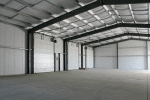
There are honestly far too many materials used in construction to be able to list in a single article. Even narrowing it down to wall construction, you can use everything from steel to engineered plastics. If you are contemplating constructing a building of any kind, your first job is to fully understand that building’s intended use. Don’t waste time thinking about materials (there are far too many options) until you know exactly what you are trying to accomplish with your new building. For the purposes of this article, we will be looking at instances where steel buildings are the way to go.
1) Stand-Alone Sheds
If you are building an attached room or some other form of addition to a standing structure, steel is not the best way to go. In those scenarios, it is best to continue using the same materials as the existing structure, allowing for aesthetic continuity and uniform functionality. If you are looking to quickly and cheaply build a functional, stand-alone shed, however, steel is absolutely the way to go. A steel building can withstand significant wear via the elements. It is durable and can last 15+ years in very harsh climate conditions. Steel buildings require very little maintenance, unlike their counterparts, and can be designed to meet a wide range of functionality requirements.
2) Agricultural Structures
Steel farm buildings are one of the most common uses of steel construction. Unfortunately, this category doesn’t quite apply to everyone, particularly excluding those not in the possession of farms. Steel buildings are frequently used in this context for many of the same reasons we like steel sheds: durability, low-maintenance, affordability, ability to withstand extreme elements, etc. The primary benefit for a farmer of owning agricultural steel buildings instead of traditional structures is the ability to spend less time on maintenance and more time finishing all the important work inherent in having a large farm. And these structures aren’t just limited to large grain barns: they include storage buildings, a steel dairy or horse barn, riding arenas, and much more.
3) As The Framework For Pretty Much All Other Commercial Buildings
Typically, your average home is going to be built with a wooden framework. Domestic homes do not need the support strength of steel, and having a structure of that weight can actually pose a danger to the homeowner and his or her family. For commercial buildings, however, steel is almost always the way to go. Such buildings benefit tremendously from steel’s strength to weight ratio, and typically require steel’s increased durability for cost-effectiveness purposes. It is extremely rare to find a commercial or industrial building that does not use a steel frame as the foundation of it’s construction.
We hope this quick look at the best and most typical uses for steel in construction was helpful for you. Best of luck in all your building endeavours.
Tiffany Olson is a blogger from Northern California who blogs on many topics including metal siding, metal buildings, steel buildings, and other constrution topics. When she's not blogging, you'll usually find her reading, outside enjoyin the sun, or on a road trip with good friends.
